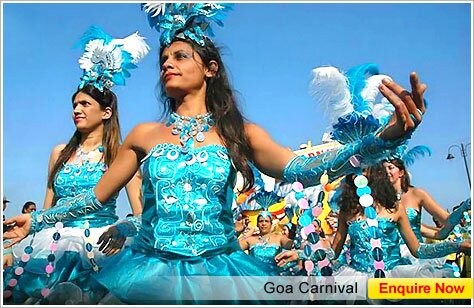The Church Of St. Cajetan, Goa
| Opposite the Se Cathedral, beyond the road is the large and beautiful church of St. Cajetan built of laterite blocks, which were lime plastered. The façade, having two towers on either side to serve as belfry, has Corinthian columns and pilasters supporting a pediment, and four niches in which are kept the statues of the apostles. The Greek Influence The main body of the church is Greek cross on plan internally and oblong externally, with a nave ending in an apse and aisles marked by four massive piers faced by Corinthian pilasters. These piers also form the base for supporting, at the crossing, a circular dome that rests on a drum and was crowned by a lantern. The ribbed vaults of the nave and aisles are of varying height and are coffered with different floral designs. The two-ocatgonal rooms having domical roofs on either side of the main altar serves as the sacristy. Click here for Tours to Goa Baroque Style Altars There are six altars besides the main one, which is dedicated to our lady of divine providence. These altars are profusely carved and gilded in Baroque style with twisted shafts and figures of angles dominating in each. The altars also have paintings on canvas of the Italian school, some depicting scenes from the life of St. Cajetan. The niches running along the sides of the vault have wooden statues of saints. The three altars on the left side, as one enters, are dedicated to the Holy family, Our Lady of Piety and St. Clare, while to the left are those of St. John, St. Cajetan and St. Agnes. There is a decorated wooden pulpit projecting from one of the piers. In the crossing is a square raised platform, which serves as a pulpit. There is a tank or a well beneath it that has led to many conjectures. Some regard that the platform covers the holy tank of a Hindu temple that once existed here, while others explain that the water reservoir at the centre of the building was deliberately planned by the architect to afford greater stability to the structure. This church, which is modelled on the original design of St. Peter's Church in Rome, is architecturally Corinthian both externally and internally while the gilded altars with rich carvings are in baroque style. The church was built by Italian friars of the Order of Theatines who were sent by the Pope Urban III to preach Christianity in the kingdom of Golconda. As they were not permitted to work there they settled down in Goa in 1640. They obtained the site in 1655 by a Royal order and the church was built in the 17th century. |
General Information |
|
Location
Old Goa, Panjim, Goa.
|
Prime AttrACTIONs of Panjim |
|
At the place where two of Goa's famous rivers meet the Arabian Sea is the secluded bay of Dona Paula with a fine view of the Marmagao Harbour. more.. |
|
Built in 1602, the only ruin of the Church of St. Augustine on the Holy Hill at Old Goa near the Nunnery, is a lofty 46-metre high tower defying the torrential rains. more.. |
|
About 2-km on the main road towards Ponda, a Kuchcha road branches off to a place where a cross is fixed. The road leads to a hill on which, commanding a picturesque view, is the Chapel of Our Lady of the Mount more.. |
|
In the Holy Hill, on the way to the Church of Our Lady of the Rosary, is a huge three-storeyed building of laterite which was originally lime-plastered but is now plastered with cement. more.. |
|
Not far to the west of the Basilica of the Bom Jesus is the Holy Hill at the extremity of which is the Church of Our Lady of the Rosary. more.. |
|
To the west of the Se Cathedral is the former palace of the Archbishop that connects the Se Cathedral to the Convent and Church of St. Francis of Assisi. more.. |
|
It is built of laterite plastered with lime mortar, with tiled roof supported by wooden rafters is a plain chapel with only one altar. more.. |
|
Aguada Fort, which crowns the rocky flattened top of the headland, is the best-preserved Portuguese bastion in Goa. Built in 1612 to protect the northern shores of the Mandovi estuary from Dutch and Maratha raiders more.. |
|
The museum has been functioning since 1964 in the abandoned convent of St. Francis of Assisi and is maintained by the Archaeological Survey of India (ASI). The collection consists of Brahmanical sculptures hero-stones and sati stones of the early and late medieval periods, portraits, coins and currency, revenue and court fee stamps, wooden and bronze sculptures and armoury of the Portuguese period. more.. |
|
The Museum of Goa is housed at a new Building at the Patto Plaze near the Ourem creek, Panaji. The most noteworthy feature of Panjim's State Archeological Museum is its imposing size, which stands in glaringly inverse proportion to the scale of the collection inside. more.. |
|
Up in the lush foothills of the Western Ghats, Bondla is good place to see Sambhar and Wild Boar. It is smallest of the Goan Wildlife Sanctuaries. Its area is 8-sq-kms but easiest one to reach. more.. |
|
A mere 45 minute bus ride up the coast from the capital, Calangute is Goa's busiest and most commercialized resort more.. |
|
On the way to Dona Paula, 1-km ahead of the confluence of the Arabian Sea and Mandvi River, under the palm shade, is "Gasper Dias" or Miramar Beach and is just 3-km away from the capital city of Panjim. more.. |
|
The Portuguese Viceroy Redondo commissioned the Se, or St. Catherine's' Cathedral, southwest of St. Cajetan's, to be "a grandiose church worthy of the wealth, power and fame of the Portuguese who dominated the seas from the Atlantic to the Pacific". more.. |
|
3-km away from Banastari Bridge on Panaji-Ponda Road is situated the noteworthy temple dedicated to Devaki Krishna at Marcel. The deity is said to have been brought from Chorao in Tiswadi to Mayem in Bicholim and then shifted to its present place during the days of religious persecution by the alien rulers. more.. |
|
Situated in West Goa, the Mahadeva Temple in Tambdi Surla is the state's only prominent reminder of the pre-Portuguese temple architecture. Maintained by the ASI (Archeological Survey of India), this 12th century temple boasts of some fine relief's on the 'Shikhara' (spire) depicting a plethora of Gods and Goddesses. more.. |
|
The temple tour can be resumed by offering prostrations unto Goddess Mahalakshmi, the presiding deity of Panaji, the capital of Goa. The main temple has been reconstructed recently. The main festivals at this temple are Navaratri and Chaitra Purnima. more.. |
|
As one tries to return to Panaji from Harvalem, one can visit the famous temple of Sri Saptakoteshwar Naroa, Bicholim. Sri Saptakoteshwara was the patron deity of the Kadambas who had built a beautiful temple dedicated to this deity at the Diwar Island. more.. |
|
From Kansarpal one can proceed to Sanquelim, the hometown of the Ranes of Satari who played key role in Goa's freedom struggle. The ancestors of the present Rane family, who are believed to have migrated to Goa from Udaipur about 600 years ago, built the famous Sri Vithal temple situated on the bank of Valvanta River. more.. |
|
Further to the west of the Church of St. Francis of Assisi is the chapel of St. Catherine. Built of laterite blocks it has a tower on either side of the façade. The chapel in the interior, having only one altar is plain more.. |
|
Nothing remains of the Church of the Carmelites excepting the façade and a raised pavement, which served as an altar. Its location is to the southeast of the Church of St. Cajetan more.. |
|
Situated to the east of the tower of St. Augustine it is a plain looking building constructed in the beginning of the 18th century. The convent was abandoned in 1835. The Society of the Misericordia occupied it for some time. more.. |
|
On the southern outskirts of Old Goa is a hill on which stand this convent and church. more.. |
|
Immediately to the south of the main road is the Professed House, a two-storeyed laterite building covered with lime plaster. Despite the opposition, which the Jesuits faced, the building was completed in 1585. more.. |
|
To the west of the tower of St. Augustine is the Royal Chapel dedicated to St. Anthony, the national saint of Portugal and held in great veneration by the Portuguese. It was built in the beginning of the 17th century. more.. |
|
Condolim Beach
Four or five years ago, Candolim, at the far southern end of Calangute beach, was a surprisingly sedate resort, appealing to an odd mixture of middle-class Bombayites, and Burgundy-clad Sannyasins taking a break from the Rajneesh Ashram at Pune. |
Hotels & Resorts in Goa |
|||
more goa hotels...
|
more goa resorts...
|
||
|
|
Suggested Tour Packages
Tour Code: GTT - 002
Duration: 4 Days / 3 Nights Destinations Covered: Mumbai - Goa |
 |
|
|
|
||
Tour Code: GTT - 003
Duration: 8 Days / 7 Nights Destinations Covered: Mumbai - Goa |
 |
|
|
|
||
Tour Code: GTT - 004
Duration: 10 Days / 9 Nights Destinations Covered: Trivandrum - Kovalam - Kanya Kumari - Vattakottai - Kovalam - Varkala - Cochin - Goa |
 |
|
|
|
||
| » Other Goa Holiday Packages | ||
North India Tour with Goa
Rajasthan Heritage with Goa
Goa Travel Package
Goa Beach Holidays
Goa Beach Vacation
Romantic Goa Honeymoon
Goa Tour Package
Travelling in Goa
Goa Vacation
Goa Trips
Goa Vacation Package
Goa Beach Tour
Rajasthan Heritage with Goa
Goa Travel Package
Goa Beach Holidays
Goa Beach Vacation
Romantic Goa Honeymoon
Goa Tour Package
Travelling in Goa
Goa Vacation
Goa Trips
Goa Vacation Package
Goa Beach Tour
... more Goa Tour Package
Goa Luxury Hotels
Hotel Taj Exotica
The Leela Palace Hotel
Bambolim Beach Resort
Majorda Beach Resort
Cidade De Goa
Hotel Taj Exotica
The Leela Palace Hotel
Bambolim Beach Resort
Majorda Beach Resort
Cidade De Goa
...more Luxury Hotels
...more Deluxe Hotels
Goa Budget Hotels
Alor Holiday Resort
Anjuna Beach Resort
Dona Paula Beach Resort
Resorte De Goa
Don Jóao Resort
Goa Guest Houses
Alor Holiday Resort
Anjuna Beach Resort
Dona Paula Beach Resort
Resorte De Goa
Don Jóao Resort
Goa Guest Houses
...more Budget Hotels
...more Goa Heritage Hotels
...more Resorts in Goa
Goa Boutique Hotels
Banayan Tree Courtyard
Devaaya Ayurvedic Spa
Montego Bay Beach Village
Vainguinim Valley Resort
Banayan Tree Courtyard
Devaaya Ayurvedic Spa
Montego Bay Beach Village
Vainguinim Valley Resort
...more Goa Boutique Hotels
...more Goa Hotels
...more South Goa Hotels
|
Plan a Tour
|
Book a Hotel
|
...more Goa Beaches
...more Goa Churches
Others
...more Travel Guide
...more Things to Do
...more Travel Guide










